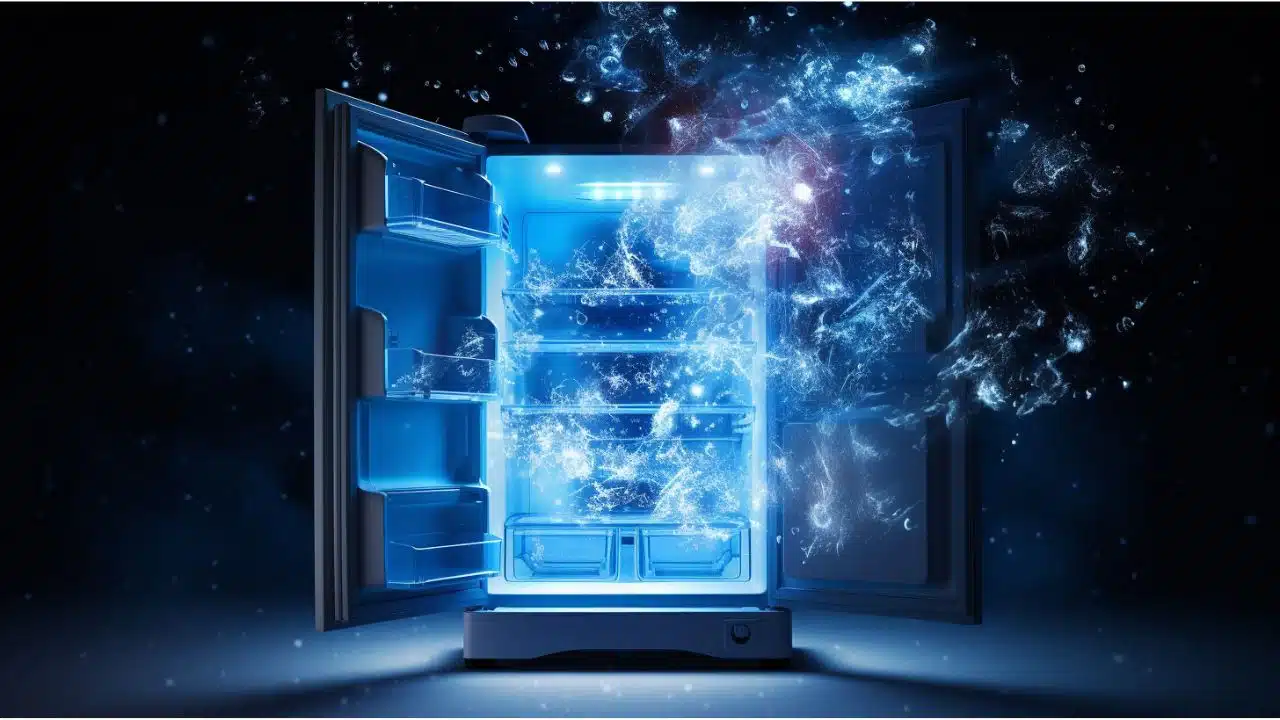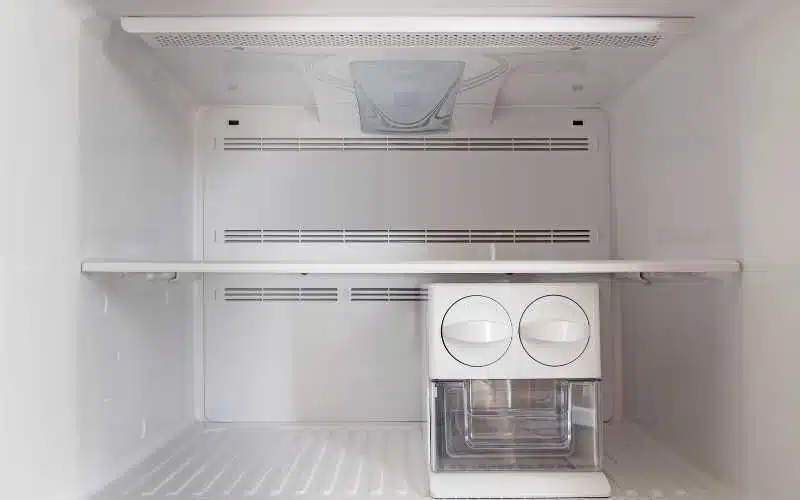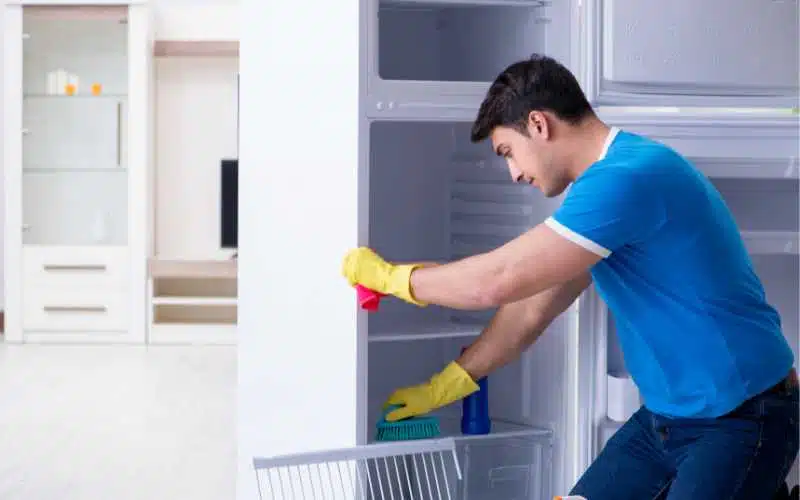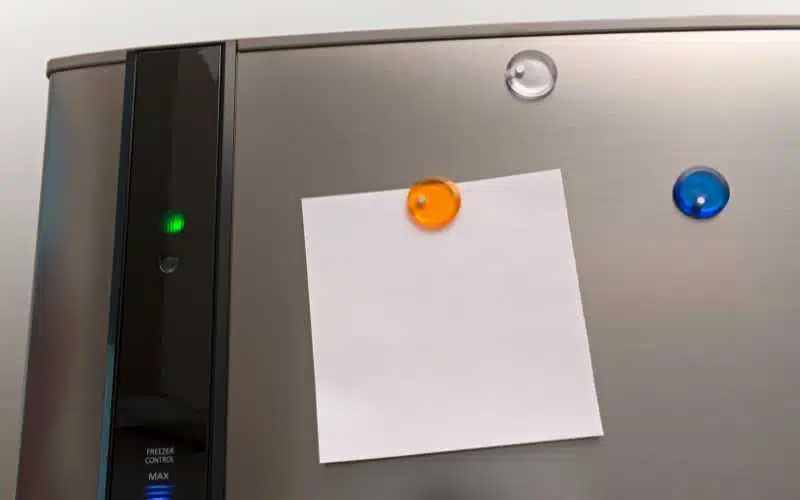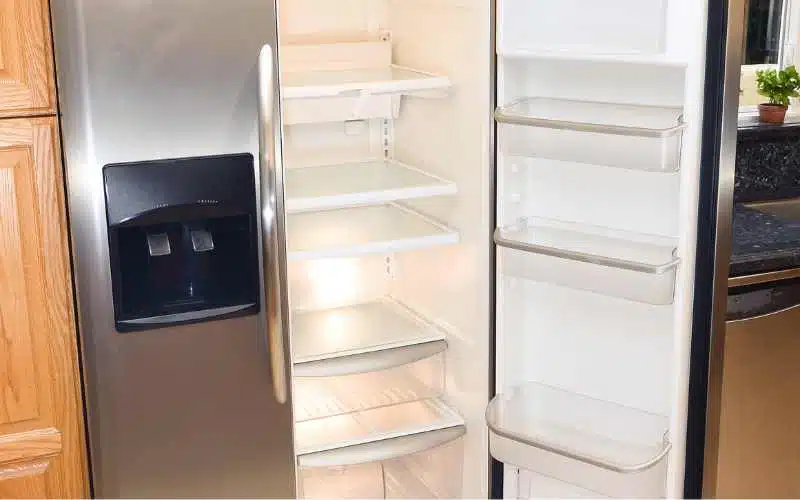One of the greatest refrigerator brands worldwide, Samsung, offers a wide variety of models in the US.
But even though they are some of the best household appliances available, they can have common issues. One of the problems is freezing up.
This problem can be frustrating, but knowing how to tackle it will give you a clear shot at maintaining your refrigerator unit.
Warm air can cause freezing up in your Samsung refrigerator. The ice dispenser flaps may also freeze due to a hole in your refrigerator. Additionally, a refrigerator could freeze up for a variety of reasons. These include an ice maker leak, a broken defrost rail, a faulty thermostat, or a broken drain clip.
Why Does Samsung Refrigerator Keep Freezing?

Ice build-up on the evaporator coils is a common problem with Samsung refrigerators.
Ice build-up happens when warm air flows across cold evaporator coils. The air first condenses, and after that, it freezes over the coils.
As a result, the coils ice over, and the defrost cycle cannot resolve this problem. You need to defrost the coils in your Samsung refrigerator if they become frozen.
To defrost the coils, You have to turn off the refrigerator for at least 24 hours. That is the simplest approach. To hasten the procedure, you can use hot water.
How Do I Stop My Samsung Refrigerator From Freezing Up?
The foundational parts of your Samsung refrigerator are what make it work correctly. Should anything go wrong with any of these components, you will experience some challenging issues.
It is advisable to keep watch and maintain these components because any problem with them impacts how well your entire fridge will function.
The table below contains some basic refrigerator components and their functions.
| Refrigerator Components | Their Function |
|---|---|
| Fluid refrigerant | It becomes a heat sink at low temperatures and a heat rejector at high temperatures. |
| Condenser coils | It retains the liquid refrigerant in place. |
| A compressor | Works to circulate the refrigerant when the system is pressure-driven |
| The evaporator coils | Cools the refrigerant to enable heat absorption |
| An extension device | Regulates the flow of refrigerant in a refrigeration system |
Having discussed the basic components of a refrigerator, we will look at ways to stop your refrigerator from freezing up.
#1. Ensure to Close the Door of Your Refrigerator Always
Leaving the refrigerator door unlocked is not good since it lets warm air in.
Warm air holds moisture, and your refrigerator unit won’t perform well when the warm air interacts with the evaporator coils. The evaporator coils will freeze if they come in contact with warm air.
#2. Clean the Door Seal of the Refrigerator
Your refrigerator’s door seal gathers debris over time. Consequently, clean and examine your refrigerator’s door seal after some time.
The door seal won’t function well if it has cracks or accumulates mold and dirt.
#3. Replace the Refrigerator’s Door Gasket or Door Seal If It Gets Old or Worn out
The soft rubber around the inner edge of your refrigerator door is the fridge door gasket.
The door gasket stops humid air from getting into the refrigeration system. The door gasket also keeps cold air within the fridge.
You are to buy and replace the door gasket of your refrigerator when it gets old or worn out.
#4. Make Sure to Close the Ice Flap of Your Refrigerator
Warm air can enter the fridge through the ice dispenser flap and the refrigerator door. Always ensure that the ice dispenser is completely closed.
You also have to Check to see whether any foreign object or ice obstructs the closure and get rid of it.
#5. Sort the Items in Your Fridge
If your refrigerator’s walls are covered in thick ice but aren’t cooling adequately, maybe some part of your refrigerator freezes up.
Space out the contents of your refrigerator evenly after rearranging them. There are air vents within refrigerators, which have to distribute cold air throughout your refrigerator unit.
The frigid air won’t circulate effectively if some of your items obstruct these air vents.
The items obstructing the vents can eventually freeze, which may cause your refrigerator’s decreased cooling capacity.
#6. Close the Gaps in the Copper Tubes
Your refrigerator’s copper tubing may leak if there is an ice build-up around it. These leaks can lead to the freezing up of your refrigerator too.
It is advisable to check and fill any openings in your unit’s copper tubes. A silicone sealant is the best thing to fill up the leaks.
#7. Fix Leaks in the Fridges Ice Maker
A split on your fridge’s ice maker’s water tube may allow water to spill into the fridge compartment.
Sometimes a leak in the ice maker may be to blame for the freezing up rather than warm air from the outside.
If you detect chilly air flowing from the inside of your refrigerator, it is necessary to close it up.
Use a low-temperature silicone sealant that is safe for food. Give it at least 24 hours to dry up. Then check your refrigerator and ice maker.
#8. Change Your Refrigerators Defrost Heather
Samsung refrigerators are frost-free. Being frost free indicates that a heater inside thaws the ice at least once daily.
Your refrigerator will continue to freeze if you have a broken defrost heater. You can get help fixing the issue by hiring a knowledgeable professional.
#9. Replace Your Refrigerator’s Thermostat
The component of the refrigerator that regulates the entire cooling system is the thermostat. Users can control the interior coolness of the refrigerator using the dial on the thermostat.
In addition, the thermostat has a digital display showing the fridge’s current temperature. A broken thermostat can result in ice build-up within your unit.
To test if your unit’s thermostat is faulty, turn the dial to the minimum level, turn it up to the maximum setting and pay close attention.
If you hear some clicking sounds, your thermostat doesn’t need to be changed. But if it’s quiet, then it’s the other way around.
You can call a qualified technician to help you fix this problem because the thermostat is a complex part of the refrigerator.
#10. Mount An Evaporator Drain Clip
If you have a broken heater and there is water on your crisper drawers, the water could freeze.
You can quickly and effectively solve the issue using an evaporator clip. The evaporator clip is a T-shaped component clip inserted to direct water directly into the drain hole.
Since the clip doubles as a conductor, it also keeps the drain line from freezing.
What Temperature Should a Samsung Refrigerator Be Set At?
You can change the Samsung refrigerator’s temperature to meet your needs. That is why the refrigerator features temperature controls.
The recommended temperature settings for the Samsung French Door refrigerator are -18°C for the freezer and 3°C for the fridge.
However, the refrigerator’s recommended setting on most models might be different.
What Are the Most Common Problems with Samsung Fridges?
In general, Samsung refrigerators are trouble-free. The normal lifespan of a Samsung refrigerator is 10 to 15 years.
But if you maintain and take care of your refrigerator properly, you may anticipate a lifespan closer to the upper end of that range.
Typical Samsung refrigerator issues include;
- A non-cooling Samsung unit.
- Water leaks.
- Disturbing noises.
- The ice maker is not dispensing ice.
- Frost and ice build up in the freezer compartment.
You have the option of resolving these issues on your own through extensive troubleshooting, or you may seek the assistance of a trained expert.
Explained below are some common problems with Samsung Refrigerators.
#1. A Non-Cooling Samsung Unit
An issue with the door seal or door gasket could cause your Samsung refrigerator not to cool properly.
Depending on how long you’ve owned the appliance, there are different ways the door gasket can fail.
The fridge won’t cool if the door seal is dusty or obstructed since it can’t establish a tight seal and will let the cold air escape.
Door seals on older Samsung refrigerators can wear out, tear, or damage over time.
You have to examine The full length of your refrigerator’s door seal. Remove any strange objects you encounter and clean up any filth you find.
#2. Water Leaks
Finding the source of the leak is the first step in troubleshooting your Samsung refrigerator if you observe water dripping from it. You can determine which part is impacted by knowing where the water originates.
Here are Three common leaks for Samsung fridges and their causes
| Leaks | Causes |
|---|---|
| Leaks at the back of the refrigerator | These leaks can result from an issue with the water inlet. |
| Leaks inside the refrigerator | These leaks can result from an issue with the water filter inside or its drawers. |
| Leaks under the refrigerator | These leaks happen when the entire refrigerator isn’t level. |
As discussed above, the cause of a leak in your Samsung fridge will depend on where the leak happens.
Suppose you find a leak behind the refrigerator. In that case, the leak is probably coming from the water supply line itself or an improperly connected hose.
An improperly installed filter or the usage of a non-Samsung filter are the most likely causes of water leaks.
You can buy a water filter replacement for this issue. When troubleshooting water leaks, you’ll need a solution depending on the primary source of the leak.
You must check the water supply line and all its connections behind your fridge regardless of the underlying problem. Verify for leaks, and make sure you tighten the screws.
#3. Disturbing Noises
Excessive noises, such as loud vibrations or knocking, indicate a problem. The evaporator fan inside the refrigerator may be the source of these noises.
Usually, a foreign object or an ice accumulation inside the fan’s housing is what the fan blades might be contracting with. Look inside the fan to determine if you need to remove any foreign objects.
The best strategy when tackling ice build-up is to turn off your refrigerator and wait for the ice to dissolve with time.
#4. Ice Maker Not Dispensing Ice
When you pull the ice dispenser lever, your refrigerator should release ice into your cup. If this doesn’t happen, the switch triggered by pulling that lever probably has a problem.
The switch for the ice maker may malfunction mechanically or electrically.
If it is electrical, a surge or short circuit may have harmed the switch and stopped it from operating properly.
Mechanically, the switch could have a piece broken off, making it unable to respond when you pull the dispenser lever.
Any issues prevent ice from dispensing when you press the lever with your cup. You must change the impacted switch to resolve this issue.
#5. Frost And Ice Build Up in the Freezer Compartment
Your freezer probably has poor ventilation if there is an accumulation of ice or frost.
Blocked air vents can cause this. Air vents are blocked when items are pushed against the freezer wall obstructing airflow.
To tackle this problem, switch off the refrigerator and leave the door open so that the ice will melt by itself. Clear the air vents in your freezer of anything that is obstructing them.
Then, arrange everything in your refrigerator so air can readily circulate between the products and containers inside.
Conclusion
If your refrigerator is freezing up, the cause can be warm air, a problem with the evaporator coils, or a faulty refrigerator component.
Your refrigerator can run at the recommended temperature, but it might not be cool enough.
The problem can arise from blocked air vents. How to tackle these and other refrigerator problems has been discussed.
